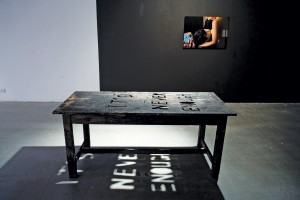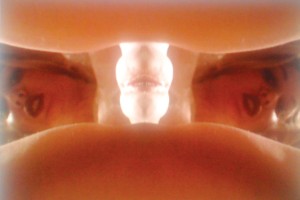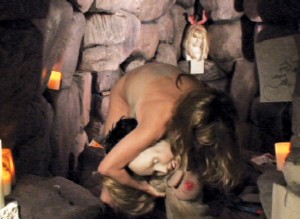« Features, Uncategorized
Within and Without the Other
An Interview with Kaari Upson
Kaari Upson is a Los Angeles-based artist who works in painting, drawing, sculpture, video, and performance. For the last several years (since graduating from CalArts in 2007) she has focused on producing work for the Larry project, an investigation on the identity of the other that pushes and creates boundaries in defining how much, and in what way, you can know a person. Using source material–old photos, journals, and documents–culled from an abandoned home in a San Bernardino neighborhood, she researches and fabricates a portrait. It is ultimately a hybrid of fact and fiction, and of his portrait and her own; in the end Larry is just as much about a specific life as it is anonymity and self.
By Cara Despain
Cara Despain - In dealing with found source material, and the resulting found identity or found portrait, how do you deal with the issue of exploitation? What are both the legal implications and your personal feelings on the matter?
Kaari Upson - The issue of exploitation is only relevant to me in terms of an unfolding; the work is about the attempt at an unobstructed biography, and all the impossibility and failing of that attempt. I am concerned with whether what I’m doing is legal, not whether if it is moral. Working with a lawyer was a preemptive measure to define how I could, legally, use the source material and to what extent she could protect me against any possible accusations, specifically defamation of character. But there are a lot of laws on the side of the artist in regards to drawing and painting, and subjective interpretation. For practical reasons the film industry has invested in protecting the rights of people with regards to their own life story, but painting and drawing have not yet caught up. The idea of subjectivity is still very gray here and I am interested in where those gray boundaries begin and end.
I have only made one editing choice in response to these legal concerns and that was with the original version of the video, The Head, in which I was strongly advised to take out any thing that appeared as speculation. The main agenda of the video was to repeat everything I knew about Larry over and over again while three actions took place: the removal of Larry’s head; the skinning of the head; and the placing of the head skin on my own head. Despite having scripted a fact-based dialogue prior to the video shoot, the final performance was still an improvised stream of consciousness, in which, thinking about the source material and images I had collected, I unconsciously filled the lulls with speculative thoughts. My lawyer informed me that she could not protect the sort of assumptive projections I was making about Larry. She could only protect my use of the facts. I started thinking about what the facts actually are, and the idea of what is concrete became more interesting. I started cutting and editing out the facts to the point that the video became absurd, and so absolutely abstract that it became even more difficult to locate any single person within the film, and in this way, I was legally protected. I became interested in combing through the work I was making and evaluating it in these legal terms.
Exploitation goes at the idea of one person, singularly victimized, but this project is not about one person. The work is about exploring the endless gray areas, within personal legal boundaries, as they pertain to a larger, philosophical understanding of individual’s limitations and relational intimacies.

Untitled, drawing installation, 2007 (detail). Pencil and ink on paper. 120” x 192.” Courtesy of the artist and the Hammer Museum of Art.
C.D. - How do you relate to or position yourself with other artists working in the similar vein of the personal lives of others as a medium (Sophie Calle, as you site as an influence; Zoe Crosher in LA; Maysle brothers; other artists you have shown with, etc.)? Is there an intrinsic voyeuristic tendency, or something that interests artists in particular when it comes to the other?
K.U. - The work has less to do with the personal lives of others as it does with the line that separates the self from the other. It is not about one subject. It is about a multiplicity of views, and shifting in and out of those multiple views. I have no interest in ever meeting or knowing Larry.
C.D. - In many instances you and Larry literally merge, and there seems to be a distinct psychological tension and fixation surrounding sex (a distant nod to Buffalo Bill, Leatherface, Judith and Holofernes?). Can you talk a little about gender identity/or the use of the interchangeable prosthetic genitals, etc. within the work?
K.U.- The woman as a source of castration or darkness is nothing new. When I began adopting female roles, I was taking, frustratingly so, from a well-established pool of filmic and literary female archetypes. I wanted to see what happened when these stereotypes were mucked up or contaminated.
C.D. - Is the backdrop of Los Angeles, which can often be obsessed with vanity, celebrity, and voyeurism, essential to the character of Larry? How has the idea (and practice of) invasive surveillance influenced your mode of portraiture?
K.U. - I don’t think Los Angeles, as understood in the terms you describe, is specific to Larry. Larry describes LA within his journals as a place in which he could find himself, and he talks about making a sort of pilgrimage towards this glistening setting sun in the west. I could be wrong in making these assumptions about his feeling of LA, but I can’t relate to what I believe is his viewpoint. I wasn’t a part of that generation, and I have a relationship to the city only as much as I was born and raised in the outskirts. I could have found Larry anywhere. For me it didn’t have to be Los Angeles.
C.D. - Can you explain the stereotypical and relatable facet to Larry’s character? Is this something you mostly created or something you gleaned from the source material? Is this, and the fusing of yourself with him, perhaps a tactic to obscure and therefore protect his real identity in some way? Is the relatability a concern as you grapple with demonizing and/or empathizing with his character? You said in a discussion that if you were to paint him as just detestable, then the project would stop there, which is an interesting thought.
K.U. - Larry’s generation was my father’s generation. It’s killing your father. It’s about the idea that the self and other could be obscured. It’s an idea that two histories can be thrown together to create new meaning. It’s about formal ideas, the question of moving and collapsing so much into itself and not knowing what will come of that collapse. I’m not fatalistic and if it were about resurrecting stereotypical male and female dynamics I wouldn’t have even started this project.
Larry might be viewed as a catalyst, accessory, or supplement. He might also be seen as a prop, mirror, or vessel. Larry is not the center.

It's Never Enough, 2008, wood and charcoal, 32” x 72” x 30.” Courtesy of the artist and Overduin and Kite.
C.D. - The research you have done on Larry explores an array of methods of information collection, ranging from forensic to entertainment-based tactics and many shades in between. This is a fascinating part of the process, and seems to be an important dimension of the work. Can you describe what you learned about Larry from these different modalities, and how using some of the same practices that he actually used (EST, etc.) put him in a cultural/chronological context? Also, could you talk specifically about the phone-sex therapy sessions you underwent that were used to create audio for The Grotto? It’s an interesting blend of fantasy and trauma that seems to dissolve the demarcation between you and Larry, reality and the sensational.
K.U. - If I had any desire, it’s a curiosity about what he is and what I am not, on a multitude of levels. Fantasy is its setting, and not in terms of acting out. Judith Butler says, “There is, then, strictly speaking, no subject who has a fantasy, but only fantasy as the scene of the subject’s fragmentation and dissimulation; fantasy enacts a splitting or fragmentation or, perhaps better put, a multiplication or proliferation of identifications that puts the very locatability of identity into question.”
The grottos stood in as both the most sacred and most profane spaces, the Playboy grotto being the most profane and the Pope’s grotto being the most sacred. Since my Larry had a very deep interest in Hefner and the life he lived, I thought I’d get at the wet spot of the Playboy empire which is the grotto. I kept reading over and over again that Hefner believed that every man’s fantasy is to have sex with identical twin sisters. I decided to ruin and bond these two forms of the grotto and use the space as a location for finding my other, my twin. I brought the doll to continue the conversation with Larry. The search for self-actualization quickly manifests into a narcissistic gesture, resulting in multiple “me”, each character with a different name, the approach continually shifting.
The initial alterations of myself began as I was attempting to gain access to the real Playboy grotto to test the water. Hefner suggests sending a picture and a little note requesting access. So I followed that advice, and each time I didn’t hear back, I just sent another altered picture of myself using real addresses. These alterations felt similar to the way Hefner moves between his seven interchangeable girlfriends. On an aesthetic level, the shifts between these girls seem to be quite slight but on a psychological level the differences are significant. I wanted to get at the complexity and complicity of that type of movement. So I began to switch between these selves and my twin, and always in relationship to Larry. The prosthetics came about as a way of improving my persona’s bodies.
C.D. - The Larry project contains some narrative and filmic approaches; almost like a character study for method acting or screenwriting that can blend reality with fiction and blur the lines of authorship. Inevitably the person who is writing or portraying the character gets entangled with the final version. I think you mentioned, and I also made the connection on several levels, to Charlie Kaufman in particular. Can you talk about this a little bit?
K.U. - I’d like to clarify that I have not incorporated this or Larry into my life. There is no losing of one’s self - there are explorations of loss but it’s the partial impossibility of never really taking on someone else’s thoughts that at this point is the focus. Through an exhaustive consumption of information and source material, so great that any hierarchy of importance diminishes, I seize upon a confrontational energy of what-ifs that manifest in art objects. To lose oneself is to suggest powerlessness. I’m interested in a voluntary (and temporary) evacuation of one’s self as an attempt to enter another world.
The only time I have actually thrown myself into the project was in the grotto when exploring the different psychological methods of self-evaluation. There is a moment when I’m talking to the sex therapist or it might have been the operator, not sure who is who anymore; but it was hilarious because it’s me who is faking it, and she, who is being paid to fake it, but who doesn’t realize that she is being filmed. There is a double take where we are both going towards the same goal which I suppose is “orgasm.” It all became quite humorous and that psychological space of what’s coming up is very intriguing and in re-watching the footage I realized I broke character in the most natural manner. I’m not an actor, nor do I want to document my personal life in a reality TV way.
I think Charlie Kaufman is great and I’m very drawn to his use of recursive themes.
C.D. - I think that in the same way people have an almost inborn curiosity about the personal lives and affects of strangers, they also, project identities onto people that they don’t know personally–often sensationalizing in the process (this is true from tabloids about celebrities to the personalities of contemporary artists). This seems to not only play into the Larry project from your role as the artist creating his character, but also a little in the way the public and press perceive or speculate about you. Do you think there is a desire to identify you as a pathological artist because of this project?
K.U. - I think to assume that I have no control over the pervasiveness of this project is to oversimplify both my intentions and my abilities. I believe I have a responsibility to the work to respond to its reception but honestly I haven’t given much thought to how it’s been written about. This project is completely in process. There is no way for it to be fully written about yet. I have always had a deep curiosity about people’s personal ephemera. My study of Larry is less about a paparazzi style grasp at access, and more about a filtering of first hand source material through my own artistic body to create new meanings, a process more akin to that of literature.




































